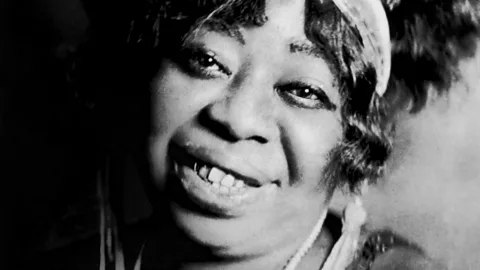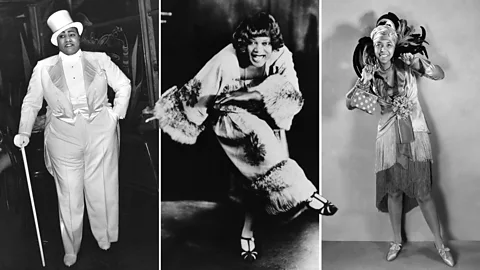 Getty Images
Getty ImagesCited as one of the first representations of black queer popular culture, Ma Rainey’s sensational Prove It on Me Blues is a landmark song that had a profound and lasting effect.
One night in 1925, a party in a Chicago apartment was broken up by police. Such raids were commonplace in the era of speakeasies and Prohibition, but this one was different: all the revellers were women and they were in a state of undress.
The singer Ma Rainey, the host of the party, known as the “mother of the blues”, was arrested. But far from hushing up the incident and the outing of her sexual interest in women, she made a record about it, Prove It on Me Blues, released in 1928.
“They say I do it, ain’t nobody caught me
Sure got to prove it on me;
Went out last night with a crowd of my friends,
They must’ve been women, ’cause I don’t like no men…”
With its out-and-proud assertion in the second verse, “I want the whole world to know,” this unapologetic proclamation of being what was then labelled as “a lady lover” is one of the world’s earliest gay anthems. Prove It on Me Blues was “one of the first representations of black queer popular culture”, Dr Cookie Woolner, associate professor of history at the University of Memphis and author of The Famous Lady Lovers: Black Women and Queer Desire before Stonewall (2023) tells the BBC. “I would imagine that the song resonated with and validated the experiences of many black women who loved women at this time,” she adds.
Born Gertrude Pridgett in 1886, this icon of female empowerment actually owed her stage name to her husband, “Pa” (William) Rainey, a comedian, singer and dancer with whom she performed a double act in minstrel shows before their separation in 1916. As a solo artist, Rainey fused the vaudeville style of her early performances with the soulful rhythms of Southern blues. In 1923, she was signed by Paramount Records and made more than 100 recordings for them, including her best-known song Ma Rainey’s Black Bottom (1927), which took its name from a crouched Charleston-like dance and inspired the play (1984) and film (2020) of the same name.
 Getty Images
Getty ImagesRainey and her gravelly contralto voice were part of a wider lesbian blues counterculture − much of it focused around Harlem, New York City − that included Gladys Bentley, Bessie Smith, Ethel Waters and Alberta Hunter. Beyond mainstream society, marginal narratives found voice in speakeasies, dive bars and “buffet flats”: apartments created within larger properties where under-the-radar entertainment took place. Bessie Smith describes this underground scene in Soft Pedal Blues (1925), which urges music makers to “put that soft pedal on” to avoid attracting the attention of the authorities. Having paid Rainey’s bail the night of her arrest, she knew the value of discretion.
Ma Rainey had a white management team and performed to both black and white audiences, bringing black queer culture into the consciousness of a diverse group of Americans. For some, this was an unwelcome commodification of black culture. In a short piece titled Harlem, which appeared in the September 1927 issue of The Crisis, the sociologist and civil rights activist WEB Du Bois lamented the “white desire for the black exotic” and the trend for white visitors to come into black communities in search of “a spectacle and an entertainment”.
A legacy of white oppression
For black performers, the blues was not just entertainment, but a sensitive art form, born from a legacy of discrimination and white oppression. “The blues as a musical genre was created by the descendants of enslaved people in the Mississippi Delta and has always been grounded in everyday life, survival, and resistance, with early blues songs discussing social issues in matter-of-fact ways,” says Woolner. “In eras when topics such as female sexuality and queerness were not considered respectable for public discussion, female blues singers nonetheless dared to broach such topics.” Blues was also, she adds, “the soundtrack” of the “Great Migration” of African Americans from the rural South to the more anonymous urban North − a move which granted black migrant women greater freedom, she says, “to take part in queer behaviours, away from the prying eyes of family and nosy neighbours”.
 Getty Images
Getty ImagesThe bawdy “hokum blues” genre reflected this freedom, laying a woman’s claim to sexual satisfaction and celebrating when she found it. Ida Cox’s One Hour Mama (1923) advocates for “endurance” in the bedroom, while Ethel Waters’ My Handy Man (1928) is rife with innuendos:
“Never has a single thing to say
While he’s working hard;
I wish that you could see the way
He handles my front yard!”
Female blues singers broadened concepts of black female identity, contesting the patriarchy and satirising domesticity. In Safety Mama (1931), for example, Bessie Smith proposes a reversal of traditional gender roles. The way “to treat a no-good man”, she sings, is to “make him stay at home, wash and iron”.
Appearance also played a role. Dressed up in ostrich plumes, diamond tiaras and necklaces made of gold coins, all while flashing her gold teeth, Ma Rainey made a deliberate show of financial independence and self-worth. Yet, like her contemporaries − most notably Gladys Bentley, famous for her stylish three-piece suits − she would also wear outfits that subverted gender norms. The advert for Prove It on Me Blues, for example, revels in her notoriety, depicting Rainey in suit jacket, tie and hat, flirting with two women while a policeman looks on. “It’s true I wear a collar and a tie,” she sings on the record.
“Crucially, these performers made black queer female possibility visible,” lecturer and researcher Eleanor Medhurst, the author of Unsuitable – A History of Lesbian Fashion (2024), tells the BBC. “They were clever with how they used clothing − it wasn’t always an overt sign of queerness… but to those in the know, or ‘in the life’ [the 1920s euphemism for lesbianism]… it meant more.”
 Alamy
AlamyBlues singers such as Ma Rainey brought a female specificity to their music, sharing themes such as infidelity and domestic violence from a woman’s perspective. Songs such as Black Eye Blues (recorded in 1928) tell a story of a woman who is not an object, whose feelings matter, but who is strong and can exact revenge.
“Take all my money, black up both my eyes
Give it to another woman, come home and tell me lies
You low-down alligator, just watch me sooner or later
Gonna catch you with your britches down.”
There’s a powerful defiance to these songs. In ‘Tain’t Nobody’s Bizness if I Do (1923), Bessie Smith stands up to criticism about her way of life. “I’m goin’ to do just as I want anyway. And don’t care if they all despise me,” she sings. Ethel Waters, who was married aged 12 or 13 to an abusive husband, and later entered into a nine-year relationship with her performance partner Ethel Williams, takes it a step further, celebrating her divorce and envisaging a life without men. “I’m gonna label my apartment ‘No Man’s Land’,” she declares in No Man’s Mamma Now (1925).
Bold and transgressive message
Until scholars such as Sandra Lieb, Daphne Duval Harrison and Angela Davis emphasised the contribution of female blues artists in shaping modern US culture, music historians had tended to overlook them, says Woolner. “There has long been this masculine idea that a lone, itinerant male blues singer, travelling the South with a guitar slung over his back, was the authentic representation of the blues,” she explains, “while female performers like Rainey, who drew from vaudeville and blackface minstrelsy, were commercial entertainers and not artists.”
Within this subversive and uncompromising blues scene, Prove It on Me was an anthem of prime importance. It was, notes Davis, “a cultural precursor to the lesbian cultural movement of the 1970s”. A cover version of it even featured in the 1977 anthology Lesbian Concentrate, a record released in response to anti-gay campaigning.
The song, agrees Woolner, was seminal. “Few other sites in 1920s American culture allowed for such bold messages about gender transgression and same-sex desire as Prove It on Me Blues,” she says. A song can have a profound effect on a community, as Rainey was well aware. “The blues helps you get out of bed in the morning,” her character says in the play. “You get up knowing you ain’t alone. There’s something else in the world. Something’s been added by that song.”


